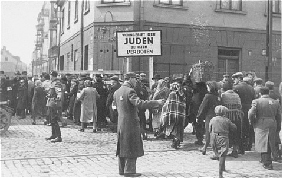
Home > Archive > For teachers > Holocaust (History)
![]()
The study of the Holocaust is an integral part of the curriculum in many middle and high school classrooms. While few social studies classes can devote enough time to provide an in-depth study of the Holocaust, language arts classes can supply additional information and amplify discussion through studying novels like The Diary of Anne Frank and Elie Wiesel’s Night.

Photo Archive #37316 from ushmm.org
While it can be challenging to convey the severity and gravity of the Holocaust, students can relate to the individuals and families who were so deeply affected by the Nazi regime by studying the ghettos of the Holocaust. In this lesson, students will be exposed to direct instruction, group discovery, individual inquiry, hands-on learning, and written expression. In addition, the use of picyNodes throughout the lesson will successfully engage students with various learning styles.
Reluctant students will enjoy the use of technology for interactive learning, while visual learners will respond to the visual organization of SpicyNodes, auditory learners will respond to web-based video and audio clips, and kinesthetic learners will enjoy the experience of creating a nodemap.
![]()
- Discipline: Integrated Language Arts; Social Studies
- Level: Grades 8 – 10
- Objective: Compare ghettos of the Holocaust; Relate to and reflect on an individual from the Theresienstadt Ghetto
- Time Needed: Approximately seven 45-minute class periods


